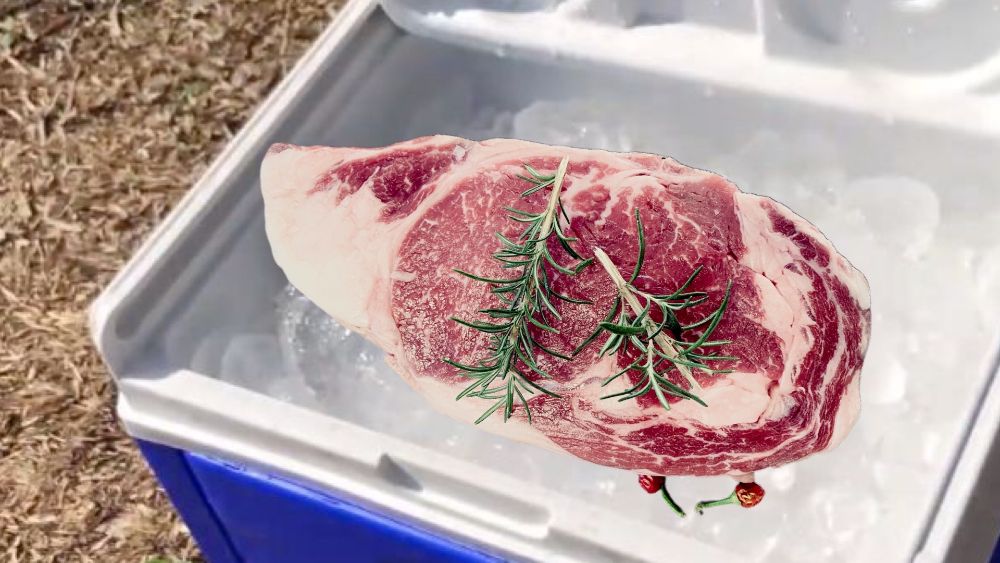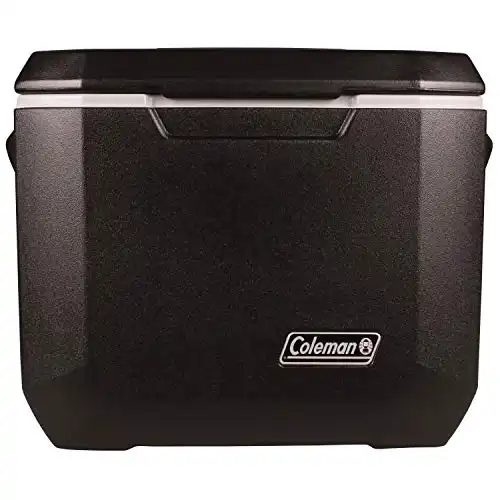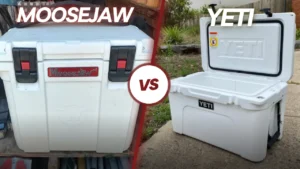For a lot of people, one of the best things about camping is cooking meat over an open fire. The smoky taste, natural char, and tender bite of slow cooking on fire always make the meat delicious.
But it's essential to keep meat cold in a cooler until you’re ready to cook it to prevent spoilage and food-borne illness. Meat can be one of the first things to go bad in your cooler and it can be a huge waste of money when it does. But how exactly do you keep meat cold in a cooler?
The best way to keep meat cold in a cooler is to start with frozen meat (if possible), pack the cooler with reusable ice packs or dry ice, and keep the cooler closed and out of direct sunlight. In a high-quality cooler meat can safely last for 2-5 days, depending on the meat.
There are a few simple packing techniques, that when done properly, can keep meat cold in your cooler for multiple days without any issues.
Keep in mind that every tip may not be right for the type of cooler or meat you are using, or for every location. Follow as many of the tips as you can for the best results.
First: Pack Your Meat In Waterproof Bags or Containers
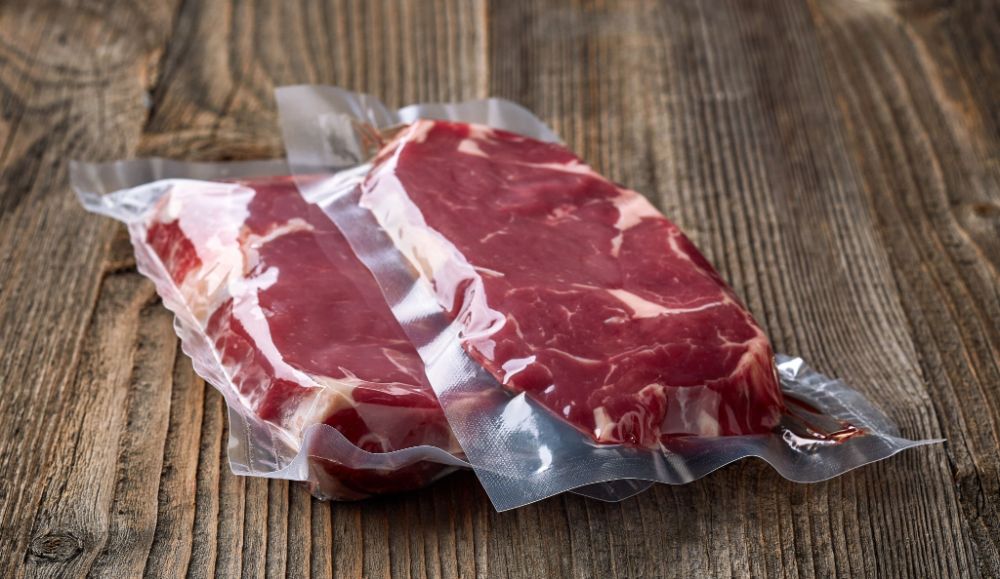
Most meat will come from the store it'll often be on some sort of tray and wrapped in plastic, or maybe from the butcher it's wrapped in plastic and then paper.
However, often in these circumstances the plastic wrap isn't completely watertight. As the ice in your cooler melts the water can seep into the plastic soaking into your meat and completely ruining it. The blood will also run through the water in your cooler and can ruin a lot of other food and make a big mess.
To protect your meat and your cooler make sure you put your meat in waterproof bags or containers.
Vacuum seal bags are ideal but I understand not everyone has access to this. Ziplock bags work great or even plastic tupperware containers.
Thin plastic bags are ideal as they allow the meat to directly touch the ice in your cooler keeping it cold.
Once you've got your meat wrapped properly follow the tips below to keep it cold in your cooler for longer.
1. Choose a High-Quality Cooler

When it comes to coolers, you generally do get what you pay for.
A really high-quality cooler like a Yeti Tundra will keep meat cold significantly longer than a simpler cooler. They are just that much better-insulated.
A high-quality cooler can keep meat cold for 4-7+ days without needing to replace the ice (if you pack it properly) and can even keep meat frozen for days. A cheap cooler from the local hardware store will only keep meat for 1-2 days without replacing the ice.
If you've got the money it's worth investing into one of the best coolers for ice retention and your meat will stay good for so much longer and it will stop wastage…it could actually SAVE you money compared to a regular cheap cooler.
However, if you budget just doesn't stretch that far there are lots of mid-range alternatives that do a good job, like the Coleman Xtreme model. Whatever you do, don’t try to keep meat cold for a long time in one of those cheap styrofoam coolers from the gas station.
Investing in a great, insulating cooler will add whole days to your outdoor eating ability!
Insulated lid and extra wall insulation makes this the best cheap cooler for ice retention.
Can hold up to 84 cans, has heavy duty wheels for easy transport and the closed lid has 4 inbuilt cup holders and can hold up to 250 lbs - making it perfect for a seat.
2. Pre-Chill the Cooler
If you’re using a high-end cooler with foam insulation inside, it’s necessary to chill the cooler itself before you add food to it because the insulation can retain a lot of heat.
Once my Dad borrowed both my high-end Yeti cooler and my cheaper Coleman Xtreme and took them away with him to a farm in summer. He left both coolers baking in the sun and when it came time to pack the coolers with ice he found that ice melted fasted in the expensive cooler.
This is because the thick insulation can absorb A LOT of heat, which can warm up everything really quickly. So before you pack all that expensive meat it's important you pre-chill the cooler first.
This tip means planning ahead, but it makes a big difference for keeping meat cold in a cooler.
The best way to chill a cooler is to fill it with ice several hours before you plan to use it. Then replace that ice with fresh ice before putting your food in.
Pre-chilling is not necessary for cheaper all-plastic coolers, but it doesn’t hurt.
If you don’t have ice to spare, at least try to put the cooler somewhere out of heat before you use it, such as in a shady garage or basement on a cool concrete floor.
3. Pack Meat at the Bottom of the Cooler
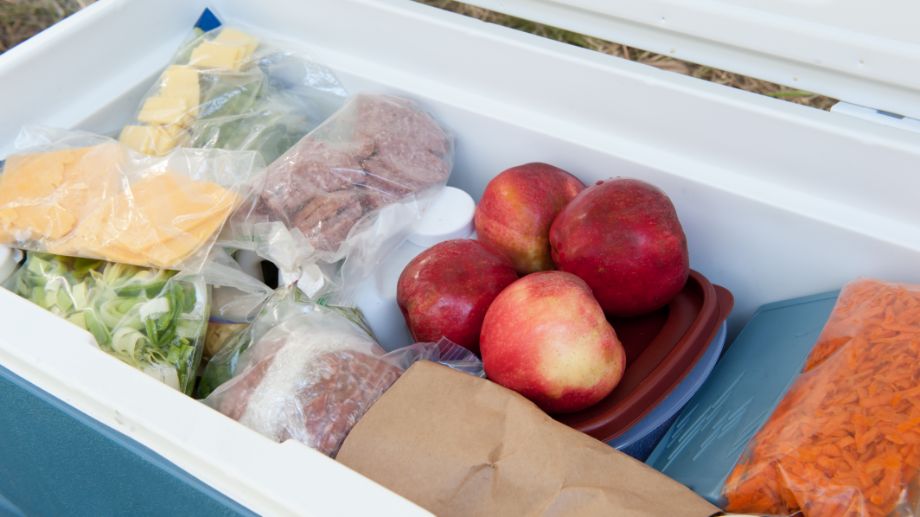
Heat rises in any environment, and cold air sinks to the bottom.
Take advantage of this principle by putting the meat at the bottom of the cooler. It will be the coolest place inside!
This also helps to protect the meat from fluctuating temperatures when you open the cooler and let warm air in.
4. Don’t Open the Cooler
This might be the single most important tip for keeping meat cold in a cooler: keep the lid closed as much as possible.
Every time you open the lid, warm air enters the insulated environment and cuts minutes or hours off of the cooling time.
Plan ahead and consider stacking food in the order you plan to use it so you can quickly open the cooler, retrieve the food, and close it again.
Using a separate cooler for drinks and food is a great idea. You will probably want multiple drinks per day, so they can stay in a cooler that won’t warm up the meat when you open it.
5. Chill or Freeze the Meat First
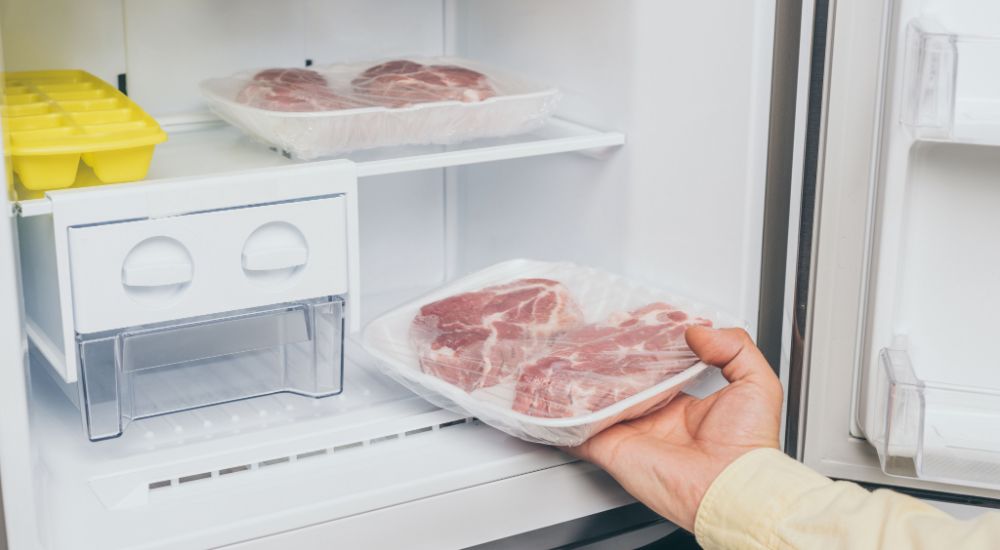
Unless you are dealing with fresh, warm meat from hunting, your meat is likely to be refrigerated before it ever goes in the cooler. But if at all possible, you should freeze the meat to keep it fresh longer in the cooler.
Frozen meat will take several hours to thaw on its own, and could take several days in a good cooler. If you are relying on a cooler for a long trip, freezing the meat is essential.
As long as you aren’t packing a premium meat like wagyu beef, freezing isn’t likely to harm the quality of the meat and will seriously extend the time it can safely spend in the cooler.
For more tips on traveling with frozen meat, click here.
6. Purchase Reusable Ice Packs
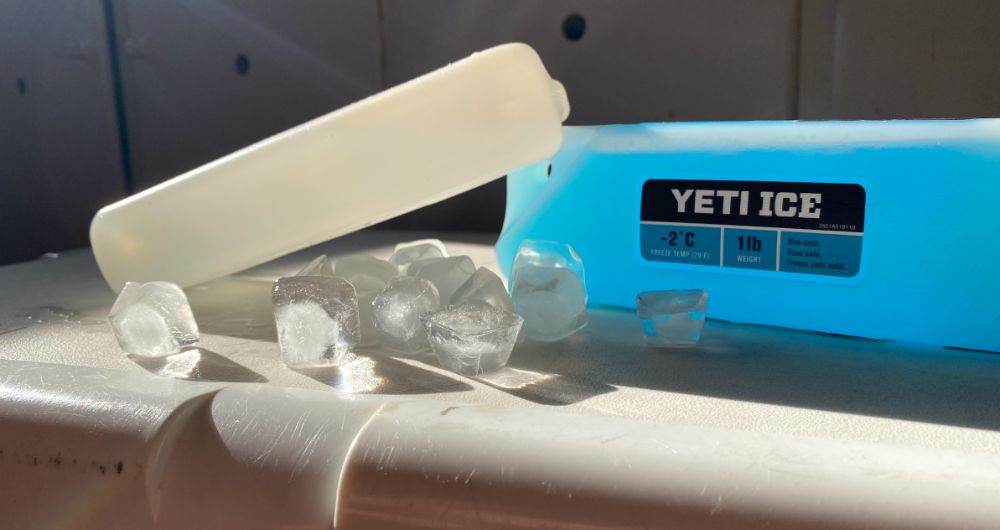
If you are going to pack meat in a cooler often, it’s worth picking up a set of large reusable ice packs.
These things are great for so many reasons:
- No mess from melted loose ice
- You’ll save money over time
- Freeze at home rather than buying ice from the store before each trip
- Less wasteful than buying bagged ice
- Fit nicely along the walls of a cooler or between layers of food
But the main reason you want to use ice packs instead of ice is that they actually stay colder than regular ice and help to keep your meat completely frozen.
You can achieve the same result with salt water ice packs that you can make at home with some leftover soda bottles, water and a good amount of salt. Or you can make salt water ice bricks from PVC tubes which work great too.
I've create a list of the best ice packs for coolers which you can choose from but if you're looking for the coldest ice pack you can't go wrong with the Engel 20 Ice Pack. This ice pack is designed to stay at 20ºF/-6.7ºC and will be more than cold enough to keep your meat completely frozen and good for days in your cooler.
This ice pack is designed to stay much colder than regular ice.
At 20ºF (-6.7ºC) it can keep food and ice cream frozen in your cooler for longer.
Just remember to clean the ice packs well in between uses, especially after coming in contact with raw meat.
7. Use Dry Ice
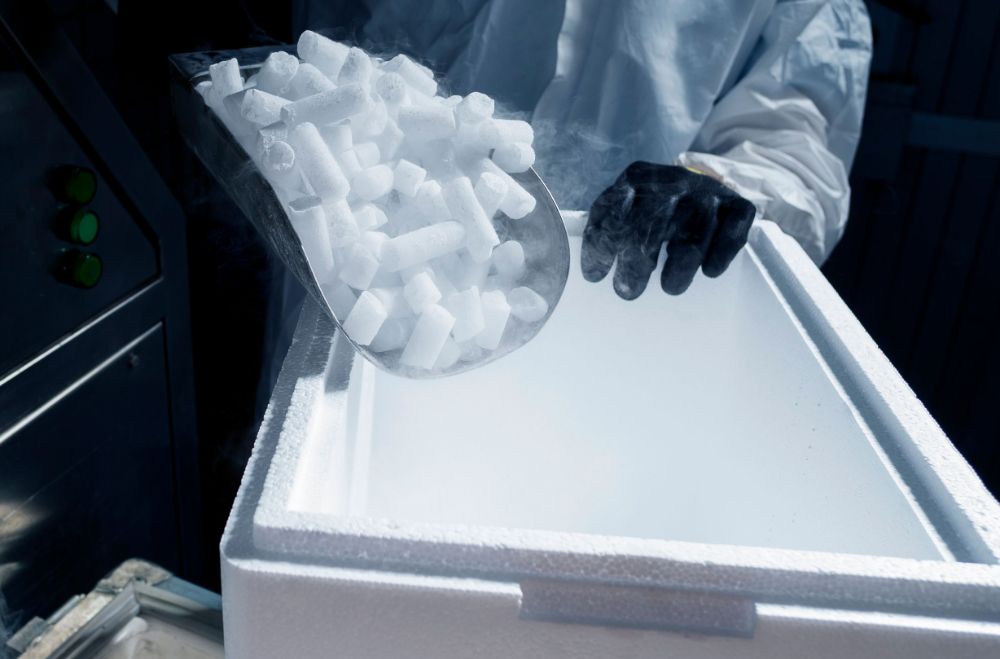
The temperature of dry ice measures at a temperature of -109.2°F/-78.5ºC (much colder than the 32-40°F/0-4ºC required to keep meat frozen or chilled).
Not only is dry ice really cold, it also does not melt into a lot of water and leave your food soggy. This is why ship-to-home meal companies use dry ice packs to ship meat and other foods across the country.
It can be difficult to obtain dry ice in some areas, but it is super effective. It will usually last 24-48 hours in a cheap cooler before it evaporates, and can last for 5+ days in a yeti cooler before it's all gone.
Dry ice will keep meat frozen as long as there is dry ice around. But even once it's gone the meat tends to stay frozen from another 12-48 hours depending on the quality of your cooler and whether or not you also have regular ice in there as well.
If your outdoor conditions are super hot and you absolutely must keep your meat cold in a cooler for multiple days, dry ice is one of the best options.
Just make sure to separate the meat from the dry ice using cardboard or towels and the dry ice can actually make the meat too cold and potentially ruin it.
8. Keep the Cooler Out of Sunlight
Direct sunlight will heat your cooler up and hurt its ability to insulate the meat inside.
Whenever possible, keep the cooler in a place away from sunlight to prevent the heat of the sun from warming up the contents.
You might need to get creative and find shade created by:
- Trees and bushes
- Rocks
- Vehicles
- Tents
- Buildings and structures
- A makeshift canopy, like a tarp or hammock
If shade really isn’t an option where you are, bring an extra blanket to put on top of the cooler and insulate it from some of the sunlight or make a reflectix cooler cover which will reflect away a lot of the heat from direct sunlight.
Summary
To keep your meat fresh and outdoors meals tasting great, remember:
- A great cooler makes a difference
- Use reusable ice packs or dry ice
- Chill the cooler first and freeze or chill the meat first
- Pack frozen meat at the bottom of the cooler
- Avoid opening the cooler and keep it out of the sun
By following as many tips in this guide as you can, you can keep meat cold in a cooler for many more hours than before. Happy cooking!

